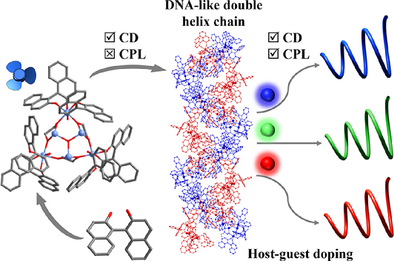Chiral Tin-Oxo Cluster Matrices with Fluorophore Embedment for Multichromatic Circularly Polarized Luminescence
Graphical Abstract
Enantiomeric tin-oxo clusters form helical supramolecular matrices through directional intermolecular interactions, enabling efficient transfer of optical handedness to encapsulated non-chiral fluorophores via spatial confinement. These assemblies exhibit tunable circularly polarized luminescence (CPL) emissions.
Abstract
Tin-oxo clusters, characterized by their well-defined chemical compositions and architectures, are multi-metal aggregates composed of Sn-oxide cores and surface ligands. Chirality, a fundamental characteristic governing biological recognition and signal transduction, remains underexplored in stannate clusters compared to extensively studied precious metal clusters. Herein, three enantiomeric pairs of chiral tin-oxo clusters were constructed using axially chiral 1,1′-bi-2-naphthol (BINOL) ligands. Structural analyses revealed supramolecular helical assemblies mediated by directional C─H···π interactions, while circular dichroism (CD) spectroscopy confirmed their intrinsic chirality. Through in situ doping engineering, non-chiral fluorophores with distinct emission profiles were incorporated during chiral cluster crystallization, yielding composite materials exhibiting circularly polarized luminescence (CPL). The optimized system achieved a maximum dissymmetry factor (glum) of 1.5 × 10−2. Mechanistic studies established that the spiral packing of the tin-oxo clusters facilitates stereochemical information transfer to the dyes via the spatial confinement effect. This supramolecular chirality induction paradigm offers new insights into the rational design of multifunctional optical materials.
Conflict of Interests
The authors declare no conflict of interest.
Open Research
Data Availability Statement
The data that support the findings of this study are available in the Supporting Information of this article.





